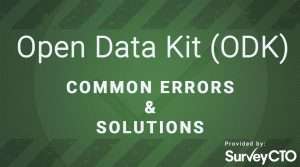At SurveyCTO, we strive to provide powerful and flexible technology that meets the needs of field researchers working in a variety of settings. We’re particularly proud of our case management capability, which enables users to operate high-quality entity-based data collection projects that require well-organized structuring of cases, multiple-step processes, and/or follow-up surveys.
In the past, we’ve highlighted innovative SurveyCTO case management use cases, such as Oxfam’s work in the Middle East, automated fieldwork management in Ethiopia, and the Magic Bus India Foundation’s digitization of its monitoring and evaluation initiatives. In this article, we draw on lessons learned to provide tips you can use for successful case management of your own data collection projects.
What is case management and when should it be used?
Case management refers to a data collection workflow centered on cases as opposed to forms. Cases can represent any unit of evaluation in your data collection project (e.g., households, patients, water pumps, etc.).
Case management is generally most appropriate for projects where researchers can pre-define specific sets of cases, and where one or more forms will need to be filled out for each predefined case. So instead of opening a form and selecting a case to work on, data collectors in the field will choose a particular case from a preloaded list. This list of cases may be filtered so that each data collector only sees the cases assigned to them. After selecting a case, the data collector can then see, select, and fill out the outstanding forms associated with that case.
The flexibility of SurveyCTO’s case management feature means that you can set up workflows of varying levels of complexity. The larger the size of the project—in terms of the number of cases, users, and follow-up surveys—the more likely it is for the implementation of case management on the ground to be complex.
Using case management for baseline surveys
If the initial step of your data collection process includes an assessment to identify cases to enroll, the case management workflow can be used to automatically screen the surveyed population based on specified criteria. This saves a lot of time that would be spent on the backend manually reviewing surveys, especially if the screened population is large. With this feature, you can also design your workflow so that qualifying cases are automatically assigned to the next stage or phase of the study. All of the collected data will be available for review and further analysis in downstream systems, such as our built-in SurveyCTO Data Explorer.
Coordinating user access
One of the most common ways to use case management is for implementing projects that require subject follow-up visits within specified time periods. For example, community healthcare workers might be required to conduct weekly home visits to assess post-treatment recovery. Similarly, in an agricultural study, data collectors may be required to measure plant growth and soil conditions at specific periods of time.
For projects like these, it’s important to create workflows that ensure that data collectors can only access a case and its associated forms at the correct time. With SurveyCTO, administrators can assign cases and approve credentials so that data collectors can only access and update cases when they’re supposed to. This is especially useful if the data collectors are from a subcontracted survey firm or working without direct supervision.
Assigning cases automatically
Case management offers a great way to effectively organize workflows when the relevance of certain forms can change based on information that is entered in earlier stages. For example, if a routine inspection of a community water pump identifies the need for repairs, case management can be used to immediately assign a secondary form to collect information about the needed repairs and then assign the case to the designated mechanic. Similarly, at the intake phase of a community health program, a patient’s case can automatically be assigned to the correct caseworker based on self-reported information collected at intake. The ability to automatically assign relevant forms and cases to the relevant data collector provides critical quality control, especially for large projects.
Using case management for endline surveys
Traditionally, logistics for follow-up or endline surveys might involve distributing lists to data collectors with information about which subjects they are responsible for interviewing (or the classic “you start from the top, I’ll start from the bottom, and we’ll meet in the middle”). This may work well if the cases are households in communities that are miles apart. In other situations, this approach might lead to overlaps and double counting that can affect the quality of collected data. Case management minimizes the risk of multiple data collectors surveying the same case. Additionally, with SurveyCTO, you can set up case lists so that each user can easily keep track of which cases have already been completed and which still need attention.
It can also be challenging to verify if data collectors have followed up with the correct subjects. If the cases are schools identified by name, the chances of going to the wrong school might be minimal. However, if data collectors are using pictures and other descriptors that are subject to change over time (e.g “the purple house” or “the second shop on the left down the hill”), this may present challenges. This is especially true if the period of time between the initial visit and the follow-up visit is significant. Successful case management design requires careful consideration of these details, in addition to incorporating local knowledge into the research design process.
Planning for internet connectivity
On the SurveyCTO platform, the case list is a server dataset that is dynamically revised and extended as users fill out forms, and these updates occur when network connection is established. If the server dataset needs to be constantly updated for immediate progression of cases to the next phase, then the devices need to be connected to an internet network. This can be a limiting factor for many users who don’t have reliable network coverage on the ground. Where possible, we recommend setting up the project to allow for internet access in between phases, so that the case list is updated before the next stage.
Determining project suitability for case management
With SurveyCTO’s case management capabilities, the sky’s the limit in terms of what you can accomplish. However, it’s important to note that not every data collection project is appropriate for this approach. For some projects, there might be logistical or management challenges on the ground that make it difficult to implement case management. Some workflows might be technically possible, but may require extended training for your data collectors.
SurveyCTO’s professional support team—one of our greatest assets—uses their own considerable field research experience to help users determine if case management is the right approach. We encourage you to reach out to the team if you are unsure about the applicability of case management to your projects.




